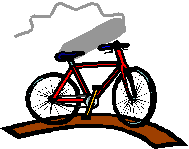 Bacterial
Movement
Bacterial
Movement Bacterial
Movement
Bacterial
Movement
In our more arrogant moments, we believe that humanity invented the wheel and this is so, in that no animal or plant uses this device.
Some bacteria do however.
Movement is, for many organisms a vital part of life. Movement gives an organism the ability to flee its own wastes and other dangerous elements and to pursue food. Not all organisms need methods of moving themselves some are happy to be carried along by currants and some do very well by being stuck in place in an environment where food comes to them and their wastes are carried away (eg the bacteria on our teeth).
So how do bacteria move?
One of the methods is by a tail. This is not the whip like tail that many people have seen in moving images of sperm swimming. Instead it is a solid construction like a corkscrew it does not work by whipping from side-to-side but twists round like a propeller. To do this, it is mounted on a wheel mounted just inside the bacterium (in black, below) that turns rapidly propelling the organism along.

Not only is the movement of the bacteria driven by a wheel, the wheel is driven by electrical power generated by the bacterium!
Bacteria with flagella at only the ends have a fairly simple set of movements that means, in effect, that they can go backwards or forwards. They are not simply limited to a single line of direction though water currents can twist them to face new directions.
Bacteria with flagella at many sites on their surface (called Peritrichous bacteria) have a more complex method of direction control.
The flagellum has been likened to a propeller when it spins anticlockwise it pushes forward and when it spins clockwise it pulls backwards (this is reversed in some bacteria).
When the flagella spin anticlockwise they all line up and it travels in a straight line. This changes when the flagella spin clockwise, at this point they are all pulling in different directions (see below) and the bacterium halts as a result as the pull is not exactly symmetrical, the bacterium changes direction so that when the flagella start spinning anticlockwise again the bacterium is taken in a different direction. This type of running-stopping-running-a-different-way makes the bacterium seem as though it is searching frantically for something.
The sort of pattern seen to this movement is shown below:

You can see that the
direction of travel is towards the blob of food at the right hand side,
but the route taken is complex. This is because when a bacterium of this type
changes direction, that change is random it is just as likely to end up
heading away from the food as towards it. The difference however is that when it
is heading towards food, it changes direction less often the longer path it
takes towards food compared to away means that the bacterium will eventually get
to its destination.
Microbiologists call this a biased random walk.
Other methods of movement are more subtle. Some bacteria, for example can only move in one direction a good illustration of this are certain pond dwellers that can move up or down in the water to reach light at the surface or food at the bottom as required they cannot move sideways through the water at all. These bacteria move by way of special compartment (vesicle) within them that can be filled with gas to make them rise (much as a modern submarine works).
Another movement type is what scientists call gliding. Gliding bacteria are those that slide slug-like across a surface when not on a surface, they have no means of movement. Little is known about how gliding occurs but it seems likely that different bacteria manage it in different ways.
t Back Return to Introduction Next u